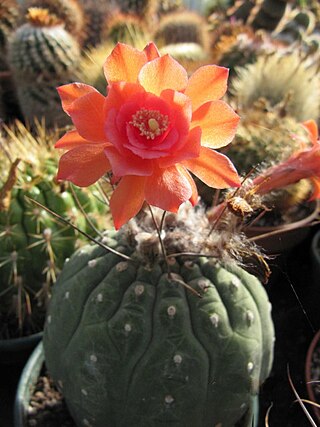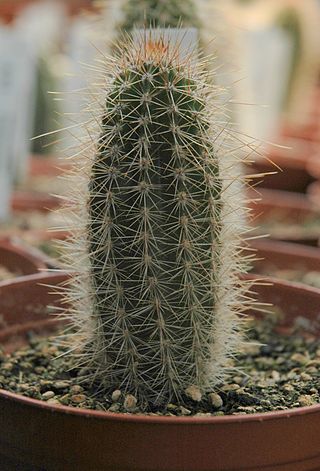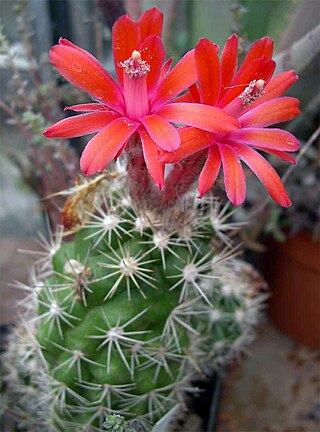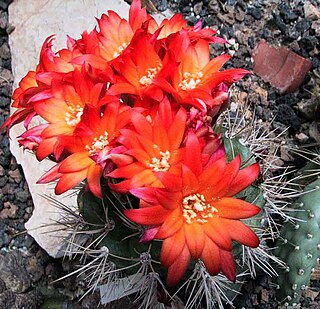
The lava cactus is a species of cactus, Brachycereus nesioticus, the sole species of the genus Brachycereus. The plant is a colonizer of lava fields – hence its common name – where it forms spiny clumps up to 60 cm (24 in) tall. Its solitary white or yellowish white flowers open in the daytime. It is endemic to the Galápagos Islands.

Mila caespitosa is a species of cacti and the only species of the genus Mila. Its generic name is an anagram of Lima, Peru, the city near which the plant is found. The genus was first thought to comprise 13 species, until recent studies suggest they form one very variable species.

The long-snouted bat is a species of bat in the family Phyllostomidae. It is the only species within the genus Platalina. It is endemic to northern Peru and northern Chile. It feeds almost exclusively on the nectar and fruit of the columnar cactus. The species is rare, but has a wide distribution with at least 25 populations, and is listed as near-threatened due to habitat loss causing the removal of their primary food source.

Trichocereus macrogonus, synonym Echinopsis macrogonus, is a species of cactus found in Ecuador, Peru and Bolivia. Two varieties are accepted as of September 2023: var. macrogonus and var. pachanoi. Plants contain varying amounts of the psychoactive alkaloid mescaline. They have been used both ritually and in traditional medicine from pre-Columbian times. Trichocereus macrogonus is one of a number of similar species that may be called San Pedro cactus. Indigenous names include achuma and huachuma, although these too may be applied to similar species.

Echinocereus berlandieri is a species of hedgehog cactus. Its range includes most of South Texas, and is commonly found along the Nueces River and the lower Rio Grande.

Matucana aurantiaca is a species of flowering plant in the cactus family Cactaceae. It grows in the Cajamarca and La Libertad regions of Peru. It is considered to have a stable population and a wide range with no threats.

Armatocereus cartwrightianus is a species of Armatocereus from Ecuador and Peru.

Armatocereus godingianus is a species of Armatocereus from Ecuador and Peru.

Armatocereus matucanensis is a species of Armatocereus from Ecuador and Peru.

Haageocereus bylesianus is a critically endangered species of Haageocereus from Peru.

Weberbauerocereus rauhii is a species of Weberbauerocereus from Peru.

Lobivia schieliana, is a species of Lobivia found in Bolivia and Peru.

Matucana intertexta is a species of cactus in the genus Matucana, native to Peru. It has gained the Royal Horticultural Society's Award of Garden Merit.

Melocactus neryi is a species of flowering plant from the genus Melocactus.

Neoraimondia arequipensis, synonym Neoraimondia macrostibas, is a tree-like cactus native to western Peru. It was first described in 1835 as Cereus arequipensis.

Neowerdermannia chilensis is a species of Neowerdermannia found in Argentina, Bolivia, Chile, and Peru.

Matucana aureiflora is a species of Matucana found in Peru.

Matucana formosa is a species of Matucana found in Peru.

Matucana tuberculata is a species of Matucana found in Peru.

Matucana oreodoxa is a species of Matucana found in Peru.





















